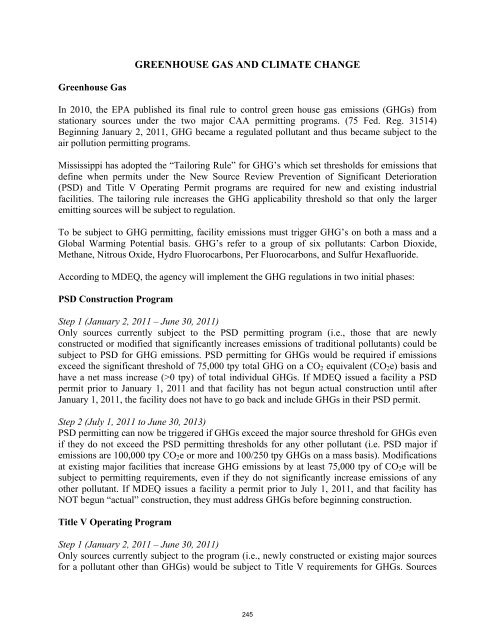in Mississippi
m2078-county-gov-ms
m2078-county-gov-ms
You also want an ePaper? Increase the reach of your titles
YUMPU automatically turns print PDFs into web optimized ePapers that Google loves.
GREENHOUSE GAS AND CLIMATE CHANGE<br />
Greenhouse Gas<br />
In 2010, the EPA published its f<strong>in</strong>al rule to control green house gas emissions (GHGs) from<br />
stationary sources under the two major CAA permitt<strong>in</strong>g programs. (75 Fed. Reg. 31514)<br />
Beg<strong>in</strong>n<strong>in</strong>g January 2, 2011, GHG became a regulated pollutant and thus became subject to the<br />
air pollution permitt<strong>in</strong>g programs.<br />
<strong>Mississippi</strong> has adopted the “Tailor<strong>in</strong>g Rule” for GHG’s which set thresholds for emissions that<br />
def<strong>in</strong>e when permits under the New Source Review Prevention of Significant Deterioration<br />
(PSD) and Title V Operat<strong>in</strong>g Permit programs are required for new and exist<strong>in</strong>g <strong>in</strong>dustrial<br />
facilities. The tailor<strong>in</strong>g rule <strong>in</strong>creases the GHG applicability threshold so that only the larger<br />
emitt<strong>in</strong>g sources will be subject to regulation.<br />
To be subject to GHG permitt<strong>in</strong>g, facility emissions must trigger GHG’s on both a mass and a<br />
Global Warm<strong>in</strong>g Potential basis. GHG’s refer to a group of six pollutants: Carbon Dioxide,<br />
Methane, Nitrous Oxide, Hydro Fluorocarbons, Per Fluorocarbons, and Sulfur Hexafluoride.<br />
Accord<strong>in</strong>g to MDEQ, the agency will implement the GHG regulations <strong>in</strong> two <strong>in</strong>itial phases:<br />
PSD Construction Program<br />
Step 1 (January 2, 2011 – June 30, 2011)<br />
Only sources currently subject to the PSD permitt<strong>in</strong>g program (i.e., those that are newly<br />
constructed or modified that significantly <strong>in</strong>creases emissions of traditional pollutants) could be<br />
subject to PSD for GHG emissions. PSD permitt<strong>in</strong>g for GHGs would be required if emissions<br />
exceed the significant threshold of 75,000 tpy total GHG on a CO 2 equivalent (CO 2 e) basis and<br />
have a net mass <strong>in</strong>crease (>0 tpy) of total <strong>in</strong>dividual GHGs. If MDEQ issued a facility a PSD<br />
permit prior to January 1, 2011 and that facility has not begun actual construction until after<br />
January 1, 2011, the facility does not have to go back and <strong>in</strong>clude GHGs <strong>in</strong> their PSD permit.<br />
Step 2 (July 1, 2011 to June 30, 2013)<br />
PSD permitt<strong>in</strong>g can now be triggered if GHGs exceed the major source threshold for GHGs even<br />
if they do not exceed the PSD permitt<strong>in</strong>g thresholds for any other pollutant (i.e. PSD major if<br />
emissions are 100,000 tpy CO 2 e or more and 100/250 tpy GHGs on a mass basis). Modifications<br />
at exist<strong>in</strong>g major facilities that <strong>in</strong>crease GHG emissions by at least 75,000 tpy of CO 2 e will be<br />
subject to permitt<strong>in</strong>g requirements, even if they do not significantly <strong>in</strong>crease emissions of any<br />
other pollutant. If MDEQ issues a facility a permit prior to July 1, 2011, and that facility has<br />
NOT begun “actual” construction, they must address GHGs before beg<strong>in</strong>n<strong>in</strong>g construction.<br />
Title V Operat<strong>in</strong>g Program<br />
Step 1 (January 2, 2011 – June 30, 2011)<br />
Only sources currently subject to the program (i.e., newly constructed or exist<strong>in</strong>g major sources<br />
for a pollutant other than GHGs) would be subject to Title V requirements for GHGs. Sources<br />
245


